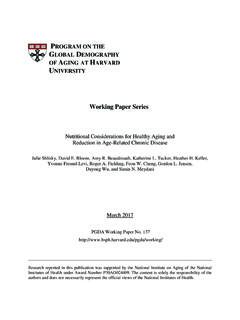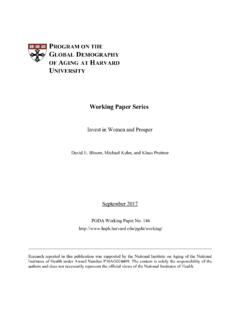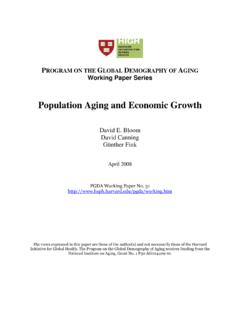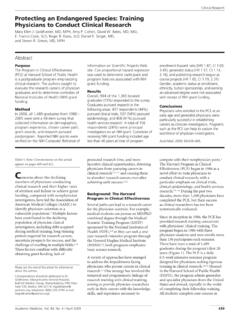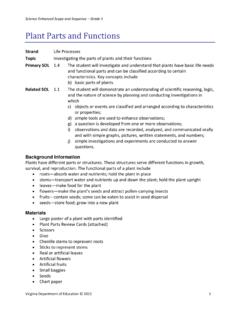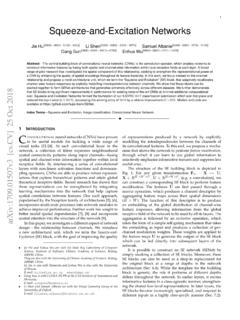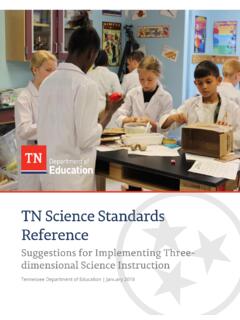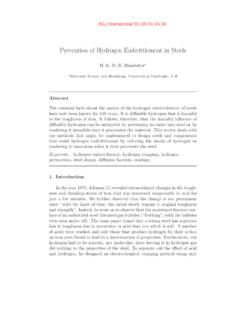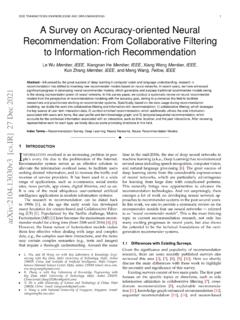Transcription of HST 190: Introduction to Biostatistics - Harvard University
1 HST 190: Introduction to BiostatisticsLecture 1:Basic principles of statistical data analysis1 HST 190: Intro to BiostatisticsWelcome! Statistical reasoning is the process of drawing scientific conclusions from data in a rational, consistent way Goals for the course: develop an intuition for the key concepts that underpin the statistical analysis of data read the Methods section of an article, and understand/critique the approach taken learn to analyze and draw scientific conclusions from your own dataHST 190: Intro to Biostatistics2 OutlineLectureTopic(s)1 Basic principles of statisticaldata analysis2 Principles of probability & Estimation of parameters3 Two-samplecomparisons, hypothesis testing and power/sample size calculations4 Clinical trials & Simple linear regression5 Multiple linearregression6 Methods for binary outcomes7 Logistic regression8 Analysisof time-to-event data9 Project presentations10 Review before the examHST 190: Intro to Biostatistics3 Course LogisticsHST 190.
2 Intro to Biostatistics4 Eight lectures each hours long Reading will be assigned prior to each lecture given the pace of the course, this is strongly encouraged Problem sets following each lecture include Matlabexercises due at 9am on the day of the following lecture (unless specified otherwise)HST 190: Intro to Biostatistics5 During breaks in the middle we will: complete group exercises learn Matlab discuss course projects You will also work on a group projectand present results during one of the class meetings In-class exam will take place during last meeting 28thAugust open-bookSuggestionsHST 190: Intro to Biostatistics6 Ask questions during the lecture as well as on Piazza take notes!
3 Material presented in different sequence from Rosner consult Rosner for a different approach Lots of material in a short time feel free to ask for help! There will be many formulae goal is not to memorize them even though we have access to software, hand calculations can help cultivate intuitionHow to PrioritizeHST 190: Intro to Biostatistics7 The course is pass/fail. Exam is open-book, so don t spend time memorizing formulas. Learn when and why to use each procedure; you can always refer to your notes to see how. To get the most out of this course, you should: attend lectures submit solutions to all the problem sets participate in class discussions, group exercises, and Piazza complete a project take the final examResourcesHST 190: Intro to Biostatistics8 Lecture Notes (Canvas -> Files) Get bonus points for finding typos!
4 Introduction to Matlab(Canvas -> Files) Rosner textbook, 7th ed. (required; a lifelong reference) Piazza Pagano & Gavreautextbook See Syllabus for additional steps of data analysis To set the stage, let s consider two motivating questions:1)is there an association between time spent in the operating room and post-surgical outcomes for lung cancer resection?2)can we develop an enhanced breast cancer risk model? The questions have been left deliberately vague! it s often the case that scientific questions are initially imprecisely posed Integral to the process of research is translating science into statistics, and back again as you read papers, it is important to consider how the authors thought through this processHST 190: Intro to Biostatistics9 There are many (possibly infinite!
5 Ways in which one could characterize basic steps but a reasonable outline might the context of the the scientific the scientific goals into statistical statistical methods to and running the 190: Intro to Biostatistics10 HST 190: Intro to Biostatistics11 Sometimes, the way forward is clear and, in that sense, the process is prescriptive features/issues that are common to all analyses In many instances, however, the way forward isn t clear aspects of the analysis don t fit in with what you currently know these may relate to the science, data and/or statistics aspects Solutions include.
6 Appealing to the published literature (scientific and statistical) adopting or adapting existing methods developing new methods Regardless, dealing with these issues will require some creativity, and there is seldom, if ever, one correct data analysis different data analyses correspond to different scientific questions which scientific question is right ?I. Understanding the Context From the perspective of a biostatistician, the purpose of data analysis is to learn about some population using information in a sample Learn about covariates in terms of association with or prediction of an outcome notationallywe often think in terms of and possibly within or across certain sub-populations denoted, say, by Context usually involves three things.
7 1)the background science2)the nature of the available data3)the population of interest, often called the target population HST 190: Intro to Biostatistics12 Lung cancer surgeryHST 190: Intro to Biostatistics13Q: Is there an association between time spent in the operating room and post-surgical outcomes? Background science: longer operating time > greater exposure to anesthesia shortening operating time might reduce adverse post-surgical outcomesocomplications during the hospital stayorecurrence of lung canceromortality may also lead to decreased costs/increased efficiencyoincreased capacity for the operating roomoshorter post-surgical hospital stayHST 190: Intro to Biostatistics14 Available data.
8 400 surgeries at Brigham and Women s Hospital performed between 1997-2008 demographic, clinical, tumor and follow-up information Target population: patients who undergo elective surgery for early stage non-small cell lung cancer need to be aware of different surgery sub-typesolobectomy, segmentectomy, wedge resectionothorachotomy, video assisted thoracic surgery what do we think about the (relatively) long time frame? generalizability beyond BWH?Breast cancer riskHST 190: Intro to Biostatistics15Q: Can we develop an enhanced breast cancer risk model?
9 Background science: the Gail model for breast cancer risk was developed in the late 1980soage, race,oage at menarche, age at birth of first childofamily history, number of prior biopsy examinations and atypical hyperplasia the model was validated in a number of subsequent studies subsequent research identified a number of additional risk factors for breast cancerobreast density, use of hormone replacement therapy and body mass indexHST 190: Intro to Biostatistics16 Available data: 2,392,998 screening mammograms from the Breast Cancer Surveillance ConsortiumoNCI-funded nationwide network of mammography registries mammograms performed between 1996-2002 outcomes are ascertained via linkages with cancer registries Target population: screening mammograms performed on women aged 35-84 yearsounit of analysis is the mammogram, not the woman who undergoes screening?
10 Who doesn t?ohow might this impact the interpretation of the study?Nature of the available dataHST 190: Intro to Biostatistics17 What were the data collection procedures? convenience sample or part of a designed study? what was the setting/timeframe? observational study or randomized design? cross-sectional, prospective, or retrospective? stratification and/or matching? How were the procedures followed? any systematic deviations from the ideal data collection process? may be due to patients?orefusal to participate/respondoinaccurate responsesHST 190: Intro to Biostatistics18 may be due to researchers?
